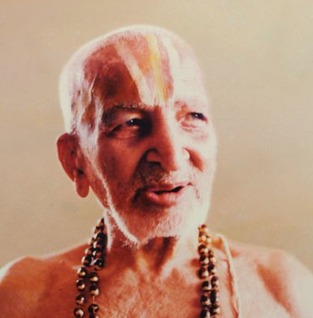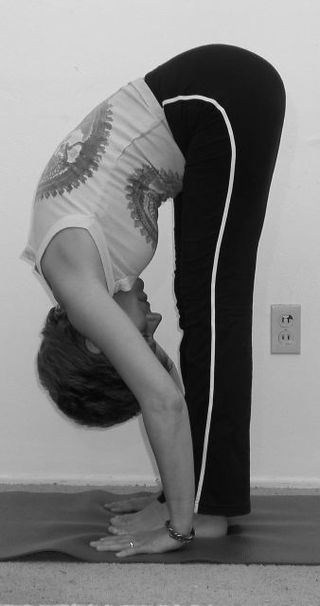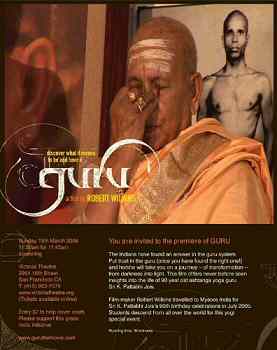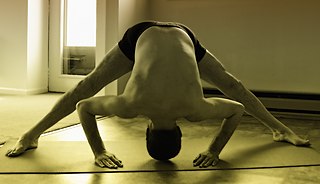
K. Pattabhi Jois was an Indian yoga guru who developed and popularized the flowing style of yoga as exercise known as Ashtanga vinyasa yoga. In 1948, Jois established the Ashtanga Yoga Research Institute in Mysore, India. Pattabhi Jois is one of a short list of Indians instrumental in establishing modern yoga as exercise in the 20th century, along with B. K. S. Iyengar, another pupil of Krishnamacharya in Mysore. Jois sexually abused some of his yoga students by touching inappropriately during adjustments. Sharath Jois has publicly apologised for his grandfather's "improper adjustments".

Ashtanga vinyasa yoga is a style of yoga as exercise popularised by K. Pattabhi Jois during the twentieth century, often promoted as a dynamic form of classical Indian (hatha) yoga. Jois claimed to have learnt the system from his teacher Tirumalai Krishnamacharya. The style is energetic, synchronising breath with movements. The individual poses (asanas) are linked by flowing movements (vinyasas).

Tirumalai Krishnamacharya was an Indian yoga teacher, ayurvedic healer and scholar. He is seen as one of the most important gurus of modern yoga, and is often called "Father of Modern Yoga" for his wide influence on the development of postural yoga. Like earlier pioneers influenced by physical culture such as Yogendra and Kuvalayananda, he contributed to the revival of hatha yoga.

Sun Salutation, also called Surya Namaskar(a) or Salute to the Sun (Sanskrit: सूर्यनमस्कार, romanized: Sūryanamaskāra), is a practice in yoga as exercise incorporating a flow sequence of some twelve gracefully linked asanas. The asana sequence was first recorded as yoga in the early 20th century, though similar exercises were in use in India before that, for example among wrestlers. The basic sequence involves moving from a standing position into Downward and Upward Dog poses and then back to the standing position, but many variations are possible. The set of 12 asanas is dedicated to the Hindu solar deity, Surya. In some Indian traditions, the positions are each associated with a different mantra.
The Mysore style of asana practice is the way of teaching yoga as exercise within the Ashtanga Vinyasa Yoga tradition as taught by K. Pattabhi Jois in the southern Indian city of Mysore; its fame has made that city a yoga hub with a substantial yoga tourism business.

Uttanasana or Standing Forward Bend, with variants such as Padahastasana where the toes are grasped, is a standing forward bending asana in modern yoga as exercise.

Guru is a British 2006 short documentary film about the guru of yoga as exercise K. Pattabhi Jois, directed by the BBC film producer Robert Wilkins. The film shows Jois and his grandson Sharath Rangaswamy teaching in the yogashala at the Ashtanga Yoga Research Institute in Mysore, India. It combined footage of beginner and advanced students practising the various Ashtanga Vinyasa Yoga series of asanas, from Primary to Advanced, with interviews with Jois and senior staff at the Institute, and street scenes in Mysore. The film also shows Jois's children Saraswati and Manju talk about their father. Wilkins took up Ashtanga Yoga two years before making the film. Wilkins spent several months in Mysore studying for the film.
The Yoga Korunta or Yoga Kuruntha is a purported 5,000 year old text on yoga, said to have been written in Sanskrit by an otherwise unknown author, Vamana Rishi, allegedly discovered by Tirumalai Krishnamacharya in the National Archives of India in the early 20th century, and supposedly lost when Krishnamacharya's only copy was eaten by ants.
A vinyasa is a smooth transition between asanas in flowing styles of modern yoga as exercise such as Vinyasa Krama Yoga and Ashtanga Vinyasa Yoga, especially when movement is paired with the breath.

Larry Schultz was an American yoga teacher who was a long-time student of the founder of Ashtanga Vinyasa Yoga, K. Pattabhi Jois. Schultz is primarily recognized as the creator of Rocket Yoga, a style derived from Jois's, which is known to be one of the original forms of Vinyasa Flow or Power Yoga.
Norman E. Sjoman is known as author of the 1996 book The Yoga Tradition of the Mysore Palace, which contains an English translation of the yoga section of Sritattvanidhi, a 19th-century treatise by the Maharaja of Mysore, Krishnaraja Wodeyar III. This book contributes an original view on the history and development of the teaching traditions behind modern asanas. According to Sjoman, a majority of the tradition of teaching yoga as exercise, spread primarily through the teachings of B. K. S. Iyengar and his students, "appears to be distinct from the philosophical or textual tradition [of hatha yoga], and does not appear to have any basis as a [genuine] tradition as there is no textual support for the asanas taught and no lineage of teachers."

Tittibhasana or Firefly pose is an arm-balancing asana with the legs stretched out forwards in hatha yoga and modern yoga as exercise. Variants include Bhujapidasana, with the legs crossed at the ankle, and Eka Hasta Bhujasana, with one leg stretched out forwards.
Jois is a surname from Indian state of Karnataka. It is mainly found among Hindus of the Brahmin community.

Prasarita Padottanasana or Wide Stance Forward Bend is a standing forward bend asana in modern yoga as exercise.

Yoga Makaranda, meaning "Essence of Yoga", is a 1934 book on hatha yoga by the influential pioneer of yoga as exercise, Tirumalai Krishnamacharya. Most of the text is a description of 42 asanas accompanied by 95 photographs of Krishnamacharya and his students executing the poses. There is a brief account of practices other than asanas, which form just one of the eight limbs of classical yoga, that Krishnamacharya "did not instruct his students to practice".
Srivatsa Ramaswami is a teacher of Vinyasa Krama yoga. He studied for 33 years under the "grandfather of modern yoga", Krishnamacharya. In India he teaches at Kalakshetra. He has run workshops in America at the Esalen Institute, the Himalayan Institute and many other centres. He is the author of four books on yoga.

The history of yoga in the United States begins in the 19th century, with the philosophers Ralph Waldo Emerson and Henry David Thoreau; Emerson's poem "Brahma" states the Hindu philosophy behind yoga. More widespread interest in yoga can be dated to the Hindu leader Vivekananda's visit from India in 1893; he presented yoga as a spiritual path without postures (asanas), very different from modern yoga as exercise. Two other early figures, however, the women's rights advocate Ida C. Craddock and the businessman and occultist Pierre Bernard, created their own interpretations of yoga, based on tantra and oriented to physical pleasure.

Postural yoga began in India as a variant of traditional yoga, which was a mainly meditational practice; it has spread across the world and returned to the Indian subcontinent in different forms. The ancient Yoga Sutras of Patanjali mention yoga postures, asanas, only briefly, as meditation seats. Medieval Haṭha yoga made use of a small number of asanas alongside other techniques such as pranayama, shatkarmas, and mudras, but it was despised and almost extinct by the start of the 20th century. At that time, the revival of postural yoga was at first driven by Indian nationalism. Advocates such as Yogendra and Kuvalayananda made yoga acceptable in the 1920s, treating it as a medical subject. From the 1930s, the "father of modern yoga" Krishnamacharya developed a vigorous postural yoga, influenced by gymnastics, with transitions (vinyasas) that allowed one pose to flow into the next.
Post-lineage yoga, also called non-lineage yoga, is a contemporary form of yoga practised outside any major school or guru's lineage. The term was introduced by the ethnographer and scholar-practitioner Theodora Wildcroft. She stated that with the deaths of the pioneering gurus of modern yoga such as B. K. S. Iyengar and Pattabhi Jois, yoga teachers, especially women, have been reclaiming their practice through their yoga communities, resisting commercialization as well as lineage.

Gurus of Modern Yoga is an edited 2014 collection of essays on some of the gurus (leaders) of modern yoga by the yoga scholars Mark Singleton and Ellen Goldberg.












